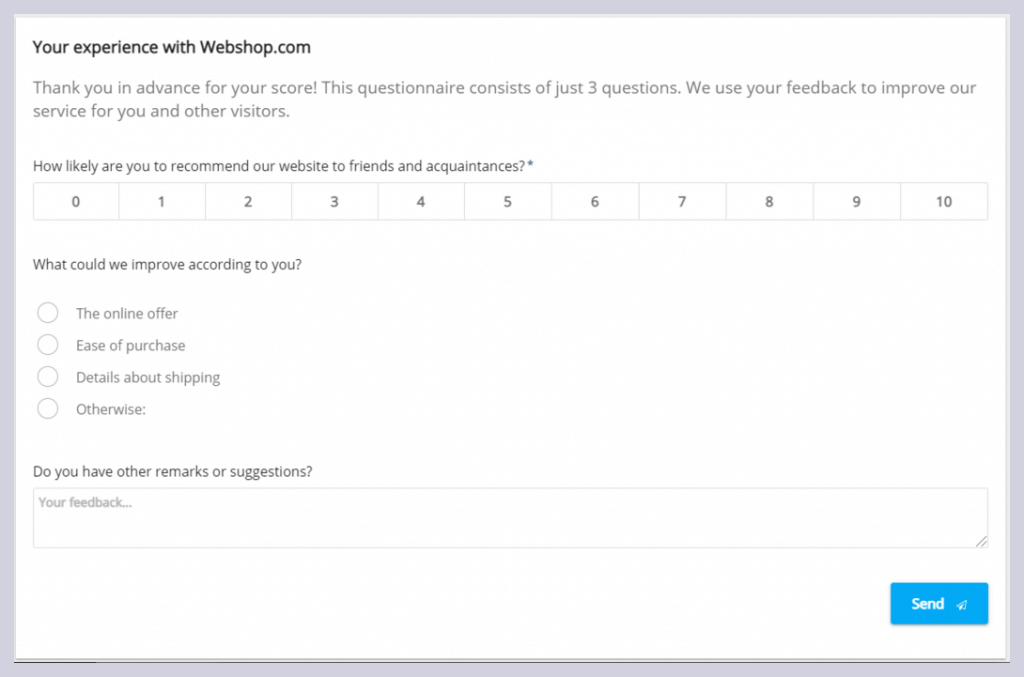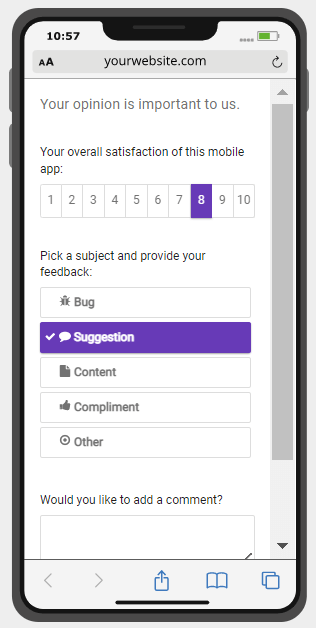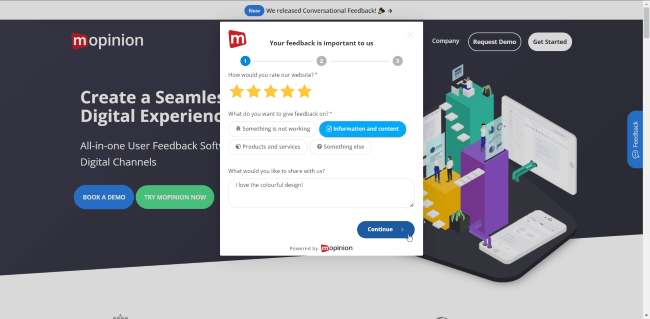Your customers have a lot to tell you, but are you listening? And with listening, we don’t mean only checking the data they provide you with. The truth is, most organisations aren’t. A Gartner marketing survey found that a mere 14% of companies have a 360-degree view of their customers. Meanwhile, there are a number of tools and strategies available for gathering these insights. Like collecting the voice of the customer, for example. In fact, voice of the customer surveys are one of the easiest, and most popular, ways of gauging how your customers are feeling and interacting with your digital channels.
So what is a voice of customer survey? Why should you use them? How can you create effective VoC surveys for your own VoC program? Keep reading to find out more…
Here is what we will cover in this post:
- What is a voice of the customer survey?
- What are the benefits of voice of the customer surveys?
- How do you conduct a voice of the customer survey?
- Voice of the customer survey templates
- 16 voice of the customer survey questions
What is a voice of the customer survey?
A voice of the customer survey (or VoC survey) gathers feedback data from your customers, which often includes both quantitative and qualitative insights. This helps the organisation to learn more about the customer experience, online journeys, and other important customer touchpoints. They are usually found on digital channels such as websites, mobile apps, and within email campaigns.
According to Forbes, data collected via voice of the customer surveys are a key component in achieving a good customer experience (CX).
“Customer data is now an integral component of business development, allowing companies to provide customers with a more personalised, frictionless experience.”
– How companies can use data to champion the voice of the customer, Forbes
Note: It’s easy to confuse a ‘voice of the customer survey’ with a ‘voice of the customer program’. A VoC survey is just one small part of the greater voice of the customer program, which consists of VoC data collection, VoC analysis, and action.

However, it is a pivotal part of your VoC program as it is the primary tool for bringing in VoC data.
What are the benefits of a voice of the customer survey?
Your customers have a voice and they want to share it.
Voice of the customer surveys give your visitors a platform to share their thoughts and opinions about your brand. Both positive and negative. In fact, more often than not the feedback you receive will be from customers who feel strongly about something. These are typically your ‘promoters’ or your ‘detractors’ who are essential to your success, as they can help you fill in your blind spots and overcome your shortcomings.
On the other hand, voice of the customer surveys also give your organisation the opportunity to reach out more proactively to other visitors. Like ones who are less motivated to provide feedback. For example, by using behaviour-triggered VoC surveys you can approach an entirely different pool of customers and gather insight into their experiences.

There is also a lot to be said about the types of data being collected in these kinds of surveys. Unlike regular website data gathered from tools like Google Analytics, VoC surveys can deliver both quantitative and qualitative insights into customer interactions. This added ingredient of sentiment enables organisations to better understand their customers on a more emotional level.
So, to summarise, a voice of the customer survey can benefit your organisation by:
- Helping you fill your blind spots and see how you can improve your customer experience.
- Allowing you to be more proactive and target different pools of customers.
- Gathering both quantitative and qualitative insights from your customers.
How do you conduct a voice of the customer survey?
So what should you take into account when creating your own VoC surveys?
1. Create VoC surveys with the customer in mind
For starters, you’re going to want to design VoC surveys with the customer in mind. This means well-designed, clear, and concise surveys that include short and unambiguous questions. In other words, it should be easy for your customers to submit their feedback. If there are any small hurdles in the mix, it might cost you.
2. Leverage metrics that line up with your goals
Before you dive into the survey creation process, think about running through your objectives for gathering VoC data. Good questions to ask yourself could be:
- What do you want to learn?
- Why are you gathering this data?
- What do you intend to do with the insights?
Once you’ve established your goals, you can start creating surveys that help you meet those goals.
For example, if you are hoping to gain insight into customer loyalty then Net Promoter Score (NPS) will be your go-to metric. Alternatively, if you want to learn more about the effort it takes your visitors to achieve any given goal on your digital channel(s), then you’ll want to deploy a survey gathering Customer Effort Score (CES).

Learn more about the different customer feedback metrics you can use to gather the insights you need.
3. Deploy VoC surveys on all of your digital channels
Our advice? Gather VoC data on all of your digital channels. Nowadays your customers see the online experience as one fluid process. They don’t see a difference between your website and your mobile app. So it is very important that these channels are fully optimised, in line with one another and ready to cater to your customers.
That being said, it is also important to point out that the approach and type of surveys you use for these different channels varies.
Types of voice of the customer surveys
- Website VoC surveys are ideal for gathering feedback on your website(s) as they help you learn where you can improve. For example, if changes are needed on certain pages or funnels that are key to your customer journey.
- Mobile VoC surveys on the other hand are great for gathering feedback within a more delicately designed environment. While you typically gather a lot of the same type of data with this channel as on the website, the surveys have to be deployed a bit differently. This is to prevent interference with the app’s design and layout. These surveys are also triggered differently from website VoC surveys.
Learn more about mobile feedback in this guide. - Email VoC surveys are designed to gather short and sweet responses about the performance of your email campaigns. This type of voice of the customer survey comes typically in the form of a thumbs up / thumbs down survey with an open comment section.
By collecting feedback within your email campaigns, you are providing a platform for two-way communication with your customers. Here, they can share their thoughts and perceptions of your email(s) and the information you’ve provided. In other words, you as a marketer gain insight into what your readers truly value.
Learn more about email feedback in this guide.

4. Gather qualitative voice of the customer data
One of the benefits of voice of the customer surveys (as opposed to website data tools) is the ability to gather qualitative data.
This type of data helps you gain an understanding into the motivation behind why your customer has provided negative or positive (quantitative) feedback. We refer to it as the “why” as it exposes the root cause behind any given behaviour:
- Why has your customer given you a low NPS score?
- Why have they decided to leave their shopping cart without making a purchase?
- Why are they idle on the page?
These are the types of questions that qualitative feedback will give you the answers to.
To gather this data, many voice of customer software solutions offer open comment fields. In these open fields, customers can provide their own explanations as to why they have given a high or low score.
Learn more about quantitative vs qualitative customer feedback.
5. Use both active and passive VoC surveys
Lastly, think about how you are going to deploy your VoC surveys. There are two different ways of deploying surveys: actively and passively.
- Active voice of the customer surveys are activated by the organisation. This means that they appear as a result of a specific behaviour from the visitor (i.e. trying to leave a page, scrolling, or time spent on a page).
- Passive voice of the customer surveys are instead readily available on the page, typically in the form of a feedback button.
There are advantages to both. Active VoC surveys are great for capturing feedback in-the-moment, while a visitor is engaged in some sort of online behaviour. Based on these, you can create tailor-made voice of the customer surveys with relevant question routing elements.

Alternatively, if you want to collect VoC data consistently throughout the journey and give your visitors the opportunity to provide feedback on their terms, you can deploy passive VoC surveys. These are great for gathering feedback on the usability of a page or for plain generic feedback.
Be sure to check out these user feedback best practices as well.
Voice of the customer survey templates
Now that you are equipped with the knowledge you need to deploy well-crafted and effective VoC surveys, let’s take a look at a few voice of the customer survey templates that might spark some inspiration and kick off the survey creation process!
Here are the most commonly used voice of the customer surveys:
1. Website survey templates
Collecting user feedback from your website is the most common way of gathering insights from visitors. And there are many different ways you can conduct these. For example, you could do a generic feedback survey which is accessible via some, or all, pages of your website (passively). Another alternative is to create an embedded survey at the bottom of a webpage, or a a popup / slide-in survey (actively).
Below you can find the most common website surveys:
NPS Surveys
Net Promoter Score (NPS) is one of the most popular loyalty metrics and is a great way of gauging customer loyalty online.
This is measured by asking a single question and offering your users a rating system from 0-10. For example:
“On a rating from 0-10: How likely are you to recommend our website to friends and acquiantances?”

You then group the answers together like below:
- Promoters (9-10)
- Passives (7-8)
- Detractors (0-6)
After this, you subtract the percentage of detractors from the percentage of promoters, and voilà! You have your Net Promoter Score, which ranges from -100 to 100.
Note: NPS is only really effective when geared towards current and/or long-time customers who are familiar with your brand. Because of this, it should never be used as a generic metric. In other words it’s better to collect NPS scores from actual customers rather than anonymous visitors who have yet to build up any sort of relationship with your brand.
CSAT Survey
Customer Satisfaction (CSAT) surveys are a great way of measuring how well your website meets the expectations of your customers. CSAT can be measured based on a particular page of your website or at an aggregated level (for example, how satisfied are your customers with the entire website).
Often companies measure CSAT using a number scale ranging from 1 to 10, by asking questions like “How satisfied are you with our website/service/product?”

Based on the answers you get a percentage, which is the Customer Satisfaction Score. 0% obviously means that you have a lot of work to do, while 100% is perfect.
2. Email feedback survey template
As previously mentioned, thumbs surveys (with a like or dislike button) are the most frequently used in email feedback campaigns. However, many organisations also use NPS surveys for post-purchase drip campaigns as well as CSAT surveys, which measure the online experience.

3. Mobile feedback survey template
You can use many of the same metrics that are used for websites for this type of feedback survey. For example, Customer Satisfaction, Net Promoter Score, Goal Completion Rate, Customer Effort Score and so on.

Check out our guide to collecting and analysing feedback for a more comprehensive list of survey templates,

Want to use our templates?
Start creating voice of the customer surveys today with Mopinion's easy-to-use software!
16 voice of the customer survey questions
So, ready to dig into the questions? As we already mentioned, which questions you use depends on:
- Your business.
- What goal your survey has.
- Whether you work B2B or B2C.
- What type of product or service you sell.
- Who your customers are.
Keep this in mind when choosing which of these questions would be relevant to your voice of the customer survey.
Value or results-based survey questions
- Did you find everything you were looking for?
- Did you find this information helpful?
- Is there a product or a service that you are missing from us?
- What are the most important qualities you look for when choosing a brand to purchase from? (Insert a multiple-choice option here)
Customer satisfaction survey questions
- On a scale of 1-10, how satisfied are you with [insert product/service/feature]?
- On a scale of 1-10, how satisfied are you with the onboarding process?
Product feedback survey questions
- What features of our product do you like the most?
- How easy would you say that it is to use our product?
- Did the product meet your expectations?
- Did you encounter any issues while using our product?
Brand loyalty survey questions
- Would you recommend our product/service to others?
- How likely are you to try another brand selling the same product/service?
- Why do you choose to buy our service/product?
Customer service survey questions
- How easy was it to interact with our support team?
- How would you rate your service today?
- Is there anything you dislike about our customer service experience?
These are only a few examples. Make sure that you sit down and take the time to understand what you want to get out of your voice of the customer survey. Then go nuts in choosing the questions that suit your needs!
Voice of the customer surveys for the win!
Voice of the customer surveys are critical to the success of your voice of the customer program. Not only do they provide you with the insights you need to improve your digital experience, but they also give your customers an opportunity to voice their feelings and opinions.
But (and this is a big but) this isn’t where it ends. Deploying voice of the customer surveys is only part of the equation. As with many improvement programs, it is critical that you carry out your voice of the customer program from start to finish and do so continuously. This means regularly collecting voice of the customer data on all relevant digital channels, analysing this feedback in your charts and dashboards, and then circling back to your customers.
Ready to start listening to your customers?
Build your very own VoC survey today. Give Mopinion a try! (Pssst, there is a free trial!)

Mopinion is an all-in-one user feedback tool that helps organisations collect and analyse website, mobile and email campaign customer feedback. It has an easy-to-use interface, with which users can build, design and configure feedback forms however they like. Mopinion users can also target specific groups of visitors with feedback forms and gain insights into why they are struggling to convert. Once collected, feedback items can be visualised in customisable dashboards and charts for advanced analyses. Additionally, digital teams can share and take action on these feedback items in a timely manner with the help of smart alerts.
Ready to see Mopinion in action?
Want to learn more about Mopinion’s all-in-1 user feedback platform? Don’t be shy and take our software for a spin! Do you prefer it a bit more personal? Just book a demo. One of our feedback pro’s will guide you through the software and answer any questions you may have.





